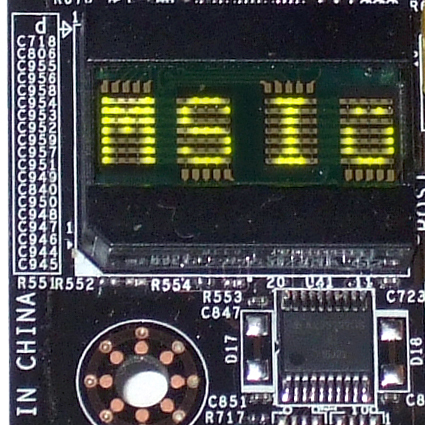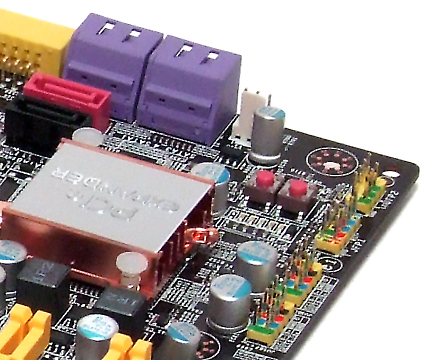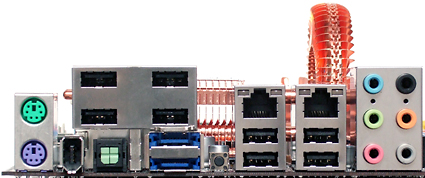X48 Motherboard Comparison
MSI X48 Platinum, Continued
A system status display near the lower rear corner is bright enough that some users will surely need sunglasses simply to determine what it says!
Photographic trickery was required simply to get a look at the device: we had to use camera flash to diminish the display's brightness, and then toned-down the "flash back" reflections of the circuits beneath using a photo editor.
MSI is the only brand in this comparison to provide a model with onboard power and reset buttons, which are perfect for bench-testing the board outside a case.
The buttons are so tiny that casual observers are unlikely to notice them. Some builders are very fond of internal buttons, but end users probably won't have much use for them once the X48 Platinum is installed into a case.
| MSI X48 Platinum (Revision) | |
|---|---|
| Northbridge | Intel X48 Express MCH |
| Southbridge | Intel ICH9R |
| Voltage Regulator | Eight Phases |
| BIOS | VP.2B4 (01/10/2008) |
| 333.3 MHz (FSB1333) | 334.5 MHz (+0.035%) |
| Clock Generator | ICS 9LPRS910BKL |
| Connectors and Interfaces | |
| Onboard | 4x PCIe x16 (Two with x4 pathways)2x PCIe x11x PCI2x USB 2.0 (2 ports per connector)1x IEEE-1394 Header1x Serial Port Header1x Floppy1x Ultra ATA (2 drives)6x Serial ATA 3.0Gb/s1x Front Panel Audio1x CD-Audio In1x VoIP interface connector2x Fan 4 pins (CPU/System)4x Fan 3 pins (System)1x Internal Power Switch1x Internal Reset Switch |
| IO panel | 2x PS2 (keyboard + mouse)2x RJ-45 Network8x USB 2.06x Analog Audio (7.1 Channel + Mic-In + Line-In)2x Digital Audio (S/P-DIF Optical+Coaxial)2x eSATA (External Serial ATA) interface1x CLR_CMOS Button |
| Mass Storage Controllers | |
| Intel ICH9R | 6x SATA 3.0 Gb/s (RAID 0,1,5,10) |
| Marvell 88SE6111 PCI-E | 1x Ultra ATA-100 (2-drives)2x SATA 3.0 Gb/s |
| Network | |
| Realtek RTL811B PCI-E | 1x Gigabit LAN Connection |
| Intel 82566DC (GLCI) PHY | 1x Gigabit LAN Connection |
| Audio | |
| HDA (Azalia) Controller Interface | Realtek ALC888T 8+2 Ch. +VoIP Codec |
| FireWire | |
| VIA VT6308P | 2x IEEE-1394a (400 Mbit/s) |
Unlike "everyone else" in today's comparison, MSI reserves its 8+2 channel codec for the more expensive "Diamond" series motherboards. The X48 Platinum's Realtek ALC888 codec is capable of 7.1-channel sound streams at a rated 97db signal-to-noise ratio, the same rating as the 8+2 channel multi-streaming ALC888T used in MSI's more expensive boards.
Also unlike its competitors, MSI takes advantage of Intel's integrated GLCI connection for one of its Gigabit Ethernet controllers. Doing so frees up a PCI Express pathway for other uses, without limiting the controller to PCI bandwidth.
PCI Express onboard devices include the Marvell 88SE6111 Ultra ATA plus SATA 3.0 Gb/s controller, and a second Gigabit Ethernet controller. The ICH9R Southbridge has but six PCI Express lanes, with the remaining four lanes dedicated to expansion slots.
Get Tom's Hardware's best news and in-depth reviews, straight to your inbox.
MSI continues to use its strange-appearing USB riser on the rear panel, to support a total of eight USB 2.0 ports in addition to a single IEEE-1394 FireWire, two External SATA, and two RJ-45 network ports. The eSATA ports are particularly interesting, in that they tie to the Intel ICH9R controller, rather than the third-party Marvell controller.
Other rear panel features include PS/2 keyboard and mouse ports, a digital optical audio output, six analog audio jacks, and a tiny CLR_CMOS button right in the middle. We found no method to disable the rear-panel CLR_CMOS button, so users will need to be particularly careful while inserting cable ends into the nearby USB and eSATA ports. Fortunately, the button is small enough to prevent "most" accidents.
Current page: MSI X48 Platinum, Continued
Prev Page MSI X48 Platinum Next Page BIOS And Overclocking-
Help please.Can this board be configured with the first two (SATA) HDs mirrored and the other drives JBOD? Thank you in advance.Reply
-
oblivionspell Great review, very detailed and informative. But I must say that either you were lucky that your X38 P5E3 Deluxe came with a better-than-average chipset or that I wasn't so lucky and got a malfunctioning one.Reply
I have an Asus Maximus Formula which is, as you know, the Republic of Gamer's solution for the X38 and recently bought a Patriot Extreme Performance 1150mhz PC2-9600. Whenever I try anything above 1020mhz for the RAM my PC reboots; the higher it is the less time it takes to do it. At 1020mhz it'll only reboot if I run something more demanding like 3dMark06 or any new game, at 1100mhz it'll barely show the Windows loading screen then reboot, above 1120mhz it'll not even load windows and freeze. But in every case it boots up fine.
The Asus forums are full of users who can't get stability in any way with >=1066mhz ram on X38 boards. A selected few have come to accomplish it however, which leads me to think those were the lucky ones who got the good shipment, like you. The Patriot forums are the same, X38 users can't get their system stable with RAMS over 1066 or not even that.
Maybe that X48 "official" support is something to consider, it might be the fix to the X38 we users are looking for. Even if it's only to make sure it'll run RAMs at >=1066mhz, it's good enough already.
-
oblivionspell - Have you tried manually setting your RAM voltage to the correct value for the performance setting(s)?Reply
I had to do this on my Asus Crosshair, even though EPP is supposed to take care of it for you. Without manually setting the voltage, I had memory corruption and crashes, but could use the non-EPP mode. With the voltage bumped to the correct 2.1V,
the EPP modes work perfectly. -
Crashman oblivionspellGreat review, very detailed and informative. But I must say that either you were lucky that your X38 P5E3 Deluxe came with a better-than-average chipset or that I wasn't so lucky and got a malfunctioning one.I have an Asus Maximus Formula which is, as you know, the Republic of Gamer's solution for the X38 and recently bought a Patriot Extreme Performance 1150mhz PC2-9600. Whenever I try anything above 1020mhz for the RAM my PC reboots; the higher it is the less time it takes to do it. At 1020mhz it'll only reboot if I run something more demanding like 3dMark06 or any new game, at 1100mhz it'll barely show the Windows loading screen then reboot, above 1120mhz it'll not even load windows and freeze. But in every case it boots up fine.The Asus forums are full of users who can't get stability in any way with >=1066mhz ram on X38 boards. A selected few have come to accomplish it however, which leads me to think those were the lucky ones who got the good shipment, like you. The Patriot forums are the same, X38 users can't get their system stable with RAMS over 1066 or not even that.Maybe that X48 "official" support is something to consider, it might be the fix to the X38 we users are looking for. Even if it's only to make sure it'll run RAMs at >=1066mhz, it's good enough already.Reply
It's just a matter of having the right RAM and using the correct timings and voltage. All X38 and X48 motherboards that support DDR2 memory can run DDR2-1066 speeds with stability, so long as the RAM is set up right in BIOS. -
"Inside, users will find a GUI based on the Smart Common Input Method (SCIM) platform."Reply
This is not accurate. SCIM is an "input method" -- a scheme for entering internationalized text. Not sure what the GUI is really based on. GTK2, maybe? -
Crashman Reply"Inside, users will find a GUI based on the Smart Common Input Method (SCIM) platform."
This is not accurate. SCIM is an "input method" -- a scheme for entering internationalized text. Not sure what the GUI is really based on. GTK2, maybe?
I see your point, but that's the same arguement as "Windows 98SE is a GUI based on DOS". Which is innacurate only in wording. It would be better to say "Windows 98SE is a GUI for DOS".
So, you'd be happier to read "Users will find a GUI for the Smart Common Input Method (SCIM) platform" correct? -
chill70 It's not only the wording. SCIM is not an operating system, so even your example is not analogous (won't even mention that DOS and Windows are separate operating systems with distinct kernels, etc).Reply
This statement is as correct as saying Vista has a GUI based on a 105-key keyboard.
SCIM is an input method platform independent on the GUI. GTK GUI is an widget toolkit, independent on SCIM (although they *may* used each other). Neither is "based" on the other.
If you want to emphasize that the Express Gate supports users of many different languages and nationalities you can mention that the GUI USES SCIM.



